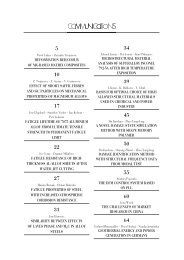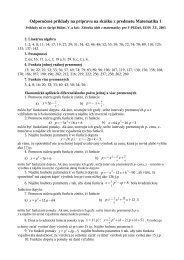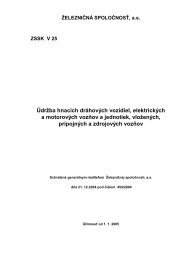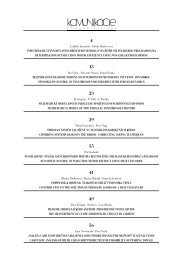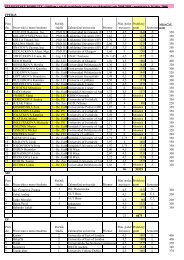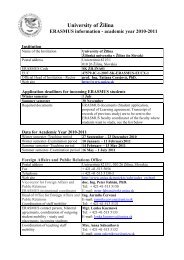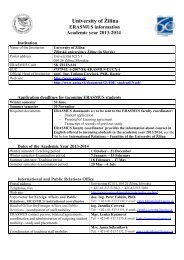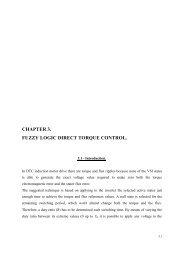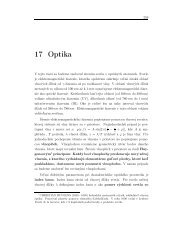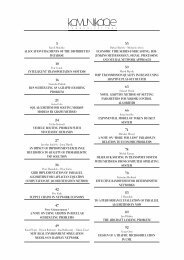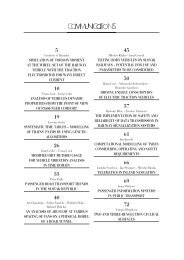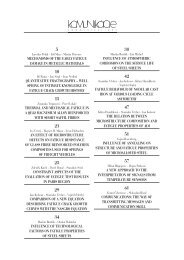posudzovanie vplyvu automobilovej dopravy na ... - Žilinská univerzita
posudzovanie vplyvu automobilovej dopravy na ... - Žilinská univerzita
posudzovanie vplyvu automobilovej dopravy na ... - Žilinská univerzita
Create successful ePaper yourself
Turn your PDF publications into a flip-book with our unique Google optimized e-Paper software.
C O M M U N I C A T I O N S<br />
I S<br />
Oldřich Polách *<br />
O KONŠTRUKCII POJAZDOV S RADIÁLNE NATÁČANÝMI<br />
DVOJKOLESIAMI<br />
ON THE DESIGN OF RUNNING GEARS WITH RADIAL STEERING WHEEL SETS<br />
Zníženie hlučnosti koľajových vozidiel môže byť dosiahnuté vhodnou konštrukciou ich podvozkov a pojazdov. Dvojkolesia <strong>na</strong>táčané do<br />
radiálnej polohy zamedzujú pískanie v oblúkoch koľaje. Okrem toho znižujú priečne sily medzi kolesom a koľajnicou aj ich opotrebenie. Konštrukčné<br />
zásady pre vývoj vzájomne viazaných, samočinne sa <strong>na</strong>táčajúcich dvojkolesí sú uvedené <strong>na</strong> príkladoch podvozkov pre nové článkové<br />
vozidlá TEŽ a spojené jednonápravové pojazdy FEBA pre predmestské súpravy NSB Class 72 firmy Bombardier Transportation Winterthur.<br />
Noise reduction of railway vehicles can be reached by suitable design of their bogies and running gears. Radial steering wheel sets avoid<br />
curve squeal. Besides they reduce lateral forces between the wheel and rail and their wear. Design principles for the development of interconnected<br />
self-steering wheel sets are introduced on examples of bogies for new articulated vehicles TEŽ and coupled single-axle running gears<br />
FEBA for commuter trains NSB Class 72 from Bombardier Transportation Winterthur.<br />
1. Environmental design of bogies and running<br />
gears for railway vehicles<br />
The influence of railway vehicles on the environment has to<br />
be considered in their design. Noise reduction is an important issue,<br />
which can be influenced by the design of bogies and running gears<br />
[1]. More than the rolling noise and impact noise on crossings,<br />
high level curve squeal in tight curves with a small curve radius<br />
annoys people who live in the vicinity of a railway line. Curve<br />
squeal is the intense to<strong>na</strong>l noise caused by wheel vibration when<br />
entering the curve [2]. The modelling and calculation of curve<br />
squeal noise generation is referenced in [3]. The excitation mechanism<br />
essentially generates lateral forces due to frictio<strong>na</strong>l instability.<br />
It is connected with lateral stick-slip motion between wheel<br />
and rail when running through a curve. The lateral creep (slip) s y<br />
is proportio<strong>na</strong>l to the angle of attack (Fig. 1)<br />
s y u y<br />
v t an <br />
tan (1)<br />
v v<br />
with u y lateral creep (slip) velocity<br />
v vehicle speed<br />
angle of attack.<br />
Reducing the angle of attack, lateral slip is reduced and the<br />
curve squeal can be avoided or at least reduced. Even when a conventio<strong>na</strong>l<br />
bogie does not squeal in a curve, the wheel-rail noise of<br />
a radial steering wheel set is lower than of a conventio<strong>na</strong>l one. The<br />
measured difference in a curve with 400 m radius reaches 3–4 dB(A)<br />
[1]. Wheel sets steered in curve into the radial position not only<br />
prevent curve squeal, they also lower track fatigue reducing the<br />
lateral wheel-rail forces and reduce the wear of wheels and rails,<br />
which is proportio<strong>na</strong>l to the friction work A R related to one meter<br />
of rail length<br />
A R ⏐X s x ⏐ ⏐Y s y ⏐ ⏐⏐ (2)<br />
with X longitudi<strong>na</strong>l force between the wheel and rail<br />
Y lateral force between the wheel and rail<br />
s x , (s y ) longitudi<strong>na</strong>l (lateral) creep in the wheel-rail contact<br />
moment around the normal axis to the contact plane<br />
spin creep in wheel-rail contact (rotation around the<br />
normal axis to the contact plane).<br />
To achieve radial adjustment of wheel sets, passive or active<br />
systems can be used. Less expensive passive systems can be divided<br />
into<br />
● self-steering wheel sets with soft guidance<br />
● inter-connected wheel sets<br />
● force-steering wheel sets.<br />
The self-steering wheel sets are characterised by soft wheel set<br />
guidance between the axle and bogie frame. The steering effect is<br />
based on the longitudi<strong>na</strong>l creep forces between the wheel and rail<br />
due to differences in the rolling path and rolling radius of the left<br />
and right wheel. The steering effect is sensitive to the conditions<br />
in the wheel-rail contact. Because of conflicting demands of selfsteering<br />
and stability, the steering effect of wheel sets with soft<br />
guidance as well as maximum speed of vehicle are limited.<br />
Inter-connected wheel sets use the same effect, but increased<br />
by the forces and moments in their coupling. They can achieve<br />
* Doc. Ing. Oldřich Polách, PhD.<br />
Bombardier Transportation Ltd, Zürcherstraße 41, CH-8401 Winterthur, Switzerland, oldrich.polach@ch.transport.bombardier.com<br />
36 ● KOMUNIKÁCIE / COMMUNICATIONS 1/2003



